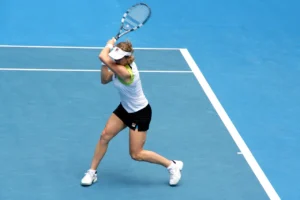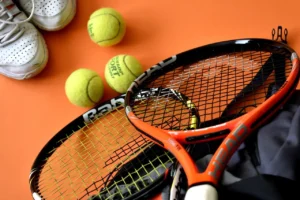Tennis is frequently referred to be the “sport of kings,” but it’s also a dance between the players and the court below their feet. Tennis is a game of talent, speed, and strategy. The type of tennis court surface used during a match can significantly alter the game’s dynamics, affecting everything from ball speed and bounce to player strategies and even the danger of injury. Come along on an interesting journey as we explore the world of tennis court surfaces and how they influence the popular sport.
Imagine the lush green of Wimbledon’s grass courts, the fiery red clay of the French Open, or the unforgiving speed of a hard court. Each court surface is a unique canvas that challenges players and provides distinct advantages and disadvantages. In this exploration, we’ll delve into the history of tennis court surfaces, unravel the science behind their composition, and uncover the strategic adaptations made by tennis pros to conquer each type of court. Whether you’re a devoted tennis enthusiast or simply curious about the sport, you’re about to discover how the ground beneath your feet can determine the destiny of a match. So, lace up your tennis shoes, grab your racket, and embark on this thrilling journey to understand how court surfaces truly shape the game of tennis.
A Brief History of Tennis Court Surfaces
Tennis has undergone many changes throughout the years. Returning to explore the intriguing history of tennis court surfaces, we can see how this cherished sport has changed. The sport of tennis, which originated in France in the 12th century, was not always played on the organised court surfaces that are now standard. Instead, it was practised in gardens and courtyards, with participants adapting to the diverse surfaces. However, the demand for uniform court surfaces increased as tennis gained popularity and sophistication.
The first significant development in tennis court surfaces occurred in the 16th century, with the emergence of grass courts. These grassy battlefields provided a relatively even playing field and became the hallmark of prestigious events like Wimbledon. Yet, it wasn’t until the late 19th century that clay courts gained recognition, introducing a new dimension to the game. The unpredictable bounce and slower pace of play on clay challenged players to adapt their strategies and skills.
Fast forward to the 20th century, and we witness the rise of hard courts composed of asphalt or concrete, adding yet another layer of complexity to the sport. Hard courts favoured powerful baseline play and showcased the evolution of tennis as a physically demanding game. As we continue our journey, we’ll explore the emergence of modern carpet and synthetic surfaces, each with unique characteristics.
Key Factors That Define Tennis Court Surfaces
To truly understand the game of tennis, one must appreciate the critical factors that define these court surfaces. In this exploration, we will dissect the key elements that make each court unique, from the material composition that shapes their character to the maintenance needs that keep them in top condition and the player experience they offer.
Material Composition
The material composition of a tennis court surface is its DNA. It determines the court’s bounce, speed, and overall playing characteristics. From the lush grass at Wimbledon to the enduring concrete of the US Open, the choice of materials varies significantly, impacting the strategy and tactics employed by players. Let’s dive into the diverse materials that shape tennis courts and unveil their influence on the game.
Maintenance Needs
Maintaining a tennis court is akin to nurturing a living entity. The specific needs of court surfaces, whether grass, clay, hard, or synthetic, are essential for preserving their integrity and ensuring fair play. Regular maintenance not only prolongs the life of the court but also guarantees a consistent playing experience for athletes. Join us as we uncover the secrets behind court upkeep and the hard work that goes into making every bounce and rally possible.
Player Experience
Tennis players often form unique bonds with the surfaces they compete on. The court becomes a silent partner in their journey, influencing their strategies and techniques. Grass courts challenge with their swift pace and low bounce, while clay courts demand endurance and finesse. Hard courts offer reliability and consistency. We’ll explore how these surfaces shape the player experience, prompting adaptations and creating unforgettable moments in the world of tennis.
Popular Types of Tennis Courts
Tennis courts come in a delightful variety, each with unique charm and challenges. Let’s explore the most popular types:
Grass Courts
Grass courts are synonymous with elegance and tradition. They provide a lightning-fast playing surface with a low bounce, making them ideal for serve-and-volley play. The lush green grass demands precision and rewards aggressive tactics. However, grass courts require meticulous maintenance to uphold their unique characteristics.
Advantages of Grass Courts
Grass courts offer a lightning-fast playing surface with a low bounce, making them a favourite among serve-and-volley players. The swift pace encourages aggressive play and rewards skilful net approaches. The lush green surface visually contrasts the vibrant green surroundings, adding to the elegance of grass court tournaments like Wimbledon.
Challenges in Grass Court Maintenance
Maintaining grass courts can be a labour-intensive task. They require meticulous care to prevent wear and tear during play, including frequent mowing and irrigation. Weather conditions, such as excessive rain, can also disrupt matches. Despite these challenges, grass courts continue to captivate players and fans with their unique characteristics.
Clay Courts
Clay courts are known for their slower pace and high bounce, favouring baseline rallies and tactical play. The forgiving surface is gentle on players’ joints and reduces the risk of injuries. The red or green clay adds drama to matches with visible marks. Players often adapt their strategies to harness the benefits of clay.
The benefits of Playing on Clay
Clay courts are known for their slow pace and high bounce, favouring baseline rallies and strategic play. The forgiving surface is gentle on players’ joints, reducing the risk of injuries. The clay’s ability to leave visible marks adds an element of drama to the game, as players can challenge line calls.
Varieties of Clay Courts: Red vs. Green
Clay courts come in two primary varieties: red clay and green clay. Red clay, composed of crushed bricks or shale, is slower and provides a higher bounce. Green clay, made of crushed basalt, offers a slightly faster pace. The choice between the two often boils down to player preference and regional tradition.
Hard Courts
Hard courts are a popular choice in both professional and recreational tennis. They feature an asphalt or concrete base covered with a durable acrylic surface. Offering a consistent and medium-paced playing experience, hard courts are accessible year-round. However, the unforgiving surface can be demanding on players’ bodies.
Composition of Hard Courts
Hard courts are asphalt or concrete covered with a durable acrylic surface. They provide a consistent, medium-paced playing experience, making them popular for both professional and recreational players. The uniformity of hard courts allows players to develop a reliable game.
Benefits and Drawbacks of Hard Courts
Hard courts offer durability and require minimal maintenance, making them accessible year-round. However, their unforgiving surface can be harsh on players’ joints, potentially leading to injuries. Players must balance their power and finesse to excel on hard courts.
Carpet Courts and Other Less Common Types
Carpet courts, though less common in professional tennis, provide a controlled environment with predictable playing conditions. Their synthetic surface allows for consistent ball bounce and quick movement. While carpet courts offer unique challenges for players, they are sensitive to temperature and humidity changes, requiring adaptation to their speed and bounce.
What Defines a Carpet Court?
Carpet courts feature a synthetic surface that provides a fast and predictable playing experience. They are less common in professional tennis but can be found in some indoor tournaments. The surface allows for consistent ball bounce and quick movement.
Benefits and Limitations
Carpet courts offer a controlled environment and consistent playing conditions, but they are sensitive to temperature and humidity changes. They provide a unique challenge for players adapting to their speed and bounce.
How Court Type Affects Gameplay
As they say, tennis is a game of inches, but it’s also a game of surfaces. The type of court you play on can dramatically alter the game’s dynamics, influencing every serve, volley, and rally. Let’s dive into how different court types affect gameplay, from the intensity of ball bounce and speed to the strategies players adopt and even the considerations of player safety.
Influence on Ball Bounce and Speed
Picture a tennis ball in flight—a fuzzy yellow missile on a trajectory that depends on the court beneath it. The court’s surface is the conductor of this symphony, dictating how high the ball bounces and how swiftly it skids. The ball zips across the surface on the low and fast hard courts, demanding quick reflexes. In contrast, clay courts slow things down, with the ball bouncing higher and giving players more time to react. Grass courts, with their unpredictable bounces, add an element of surprise to every rally. Understanding these nuances is crucial for players looking to master the art of adaptation.
Strategies Adopted by Players for Each Surface
To excel in the world of tennis, players must become surface connoisseurs. On grass, where speed reigns supreme, serve-and-volley players often dominate, charging the net with lightning-quick reflexes. Patience is a virtue on the clay, as baseline rallies test players’ endurance and strategic finesse. Hard courts invite versatility, allowing players to mix power with precision. Carpet courts, though less common, demand adaptability and quick decision-making. Mastery of these varying strategies is the hallmark of a well-rounded player.
Injury Considerations
While the thrill of tennis is undeniable, it’s not without its physical toll. Different court types can impact players’ bodies in various ways. With their unforgiving surface, hard courts can lead to joint stress and injuries, making proper footwear and conditioning essential. Players often slide into shots on the clay, adding a unique strain to their legs. Grass courts, despite their elegance, can be slippery, raising the risk of injuries from sudden movements. With their controlled conditions, Carpet courts offer fewer surprises but still require players to stay agile and injury-aware.
Embracing Diversity in Tennis Court Surfaces
Tennis is a sport that celebrates diversity, and nowhere is this more evident than in its array of court surfaces. Each surface offers its own challenges and rewards, demanding players to adapt, strategise, and evolve. As tennis enthusiasts, let’s embrace this diversity, for it’s what makes the sport endlessly intriguing. Whether you’re gliding on clay, sprinting on grass, or finding your rhythm on hard courts, each surface has its magic, offering an invitation to explore and excel. So, let’s continue to revel in the unique character of each court type, and remember, in the world of tennis, variety truly is the spice of life. Contact us at Evolve Tennis Academy to move on with your journey.







